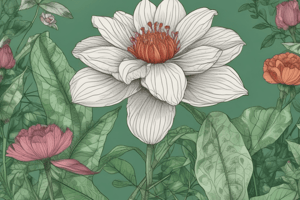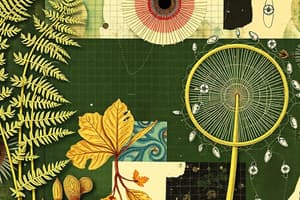Podcast
Questions and Answers
Which of the following describes the most significant distinction between angiosperms and other types of plants?
Which of the following describes the most significant distinction between angiosperms and other types of plants?
- The presence of flowers and fruits in their life cycle. (correct)
- Their ability to perform photosynthesis.
- Their reliance on water for reproduction.
- Their method of nutrient absorption from the soil.
A botanist discovers a new plant species. After observing its anatomy, they note the presence of a pistil containing a stigma, style, and ovary. Which of the following conclusions can they most reliably draw?
A botanist discovers a new plant species. After observing its anatomy, they note the presence of a pistil containing a stigma, style, and ovary. Which of the following conclusions can they most reliably draw?
- The plant is a gymnosperm.
- The plant is an angiosperm. (correct)
- The plant relies solely on wind pollination.
- The plant reproduces through spores.
In angiosperms, what is the direct result of the fusion of one sperm cell with the egg cell?
In angiosperms, what is the direct result of the fusion of one sperm cell with the egg cell?
- Creation of the zygote. (correct)
- Development of the fruit.
- Growth of the pollen tube.
- Formation of the endosperm.
How does double fertilization contribute to the evolutionary success of angiosperms?
How does double fertilization contribute to the evolutionary success of angiosperms?
If a plant species develops a mutation that prevents the formation of sepals, what is the most likely consequence for the plant?
If a plant species develops a mutation that prevents the formation of sepals, what is the most likely consequence for the plant?
A farmer notices that their squash plants are producing flowers but not forming fruits. Which of the following is the most likely explanation for this issue?
A farmer notices that their squash plants are producing flowers but not forming fruits. Which of the following is the most likely explanation for this issue?
What is the role of the generative cell within a pollen grain of an angiosperm?
What is the role of the generative cell within a pollen grain of an angiosperm?
How might a plant benefit from producing fruits that are brightly colored and attractive to birds?
How might a plant benefit from producing fruits that are brightly colored and attractive to birds?
Which of the following is the primary function of nectar in angiosperm flowers?
Which of the following is the primary function of nectar in angiosperm flowers?
A plant species has evolved a mechanism to prevent self-pollination. What is the most likely benefit of this adaptation?
A plant species has evolved a mechanism to prevent self-pollination. What is the most likely benefit of this adaptation?
Flashcards
Angiosperms
Angiosperms
Flowering plants; a highly successful and diverse group.
Fruit (Botanical Definition)
Fruit (Botanical Definition)
The ripened ovary of a plant containing seeds.
Flower
Flower
Reproductive structure of angiosperms, containing male and/or female parts.
Stamen
Stamen
Signup and view all the flashcards
Pistil
Pistil
Signup and view all the flashcards
Pollinator
Pollinator
Signup and view all the flashcards
Nectar
Nectar
Signup and view all the flashcards
Double Fertilization
Double Fertilization
Signup and view all the flashcards
Fruit (Development)
Fruit (Development)
Signup and view all the flashcards
Preventing Self-Pollination
Preventing Self-Pollination
Signup and view all the flashcards
Study Notes
Angiosperms
- Angiosperms are flowering plants that are highly successful and diverse.
- Many grasses, crops, and plants producing fruit are angiosperms.
- Fruits, by biological definition, develop from the ovary of a plant.
- Pumpkins, green beans, tomatoes, and squash are fruits because they develop from the ovary.
Vegetables aren't a true biology definition, they are leaves, stems, or plant products that are less sweet.
Flower Anatomy
Flowers can contain male and female parts, or only one part.
Flowers are the reproductive structures of angiosperms.
Stamen (Male Part)
- Stamen includes the filament and the anther.
- The filament is a stalk that supports the anther.
- The anther is a fluffy structure that produces pollen.
Pistil (Female Part)
- Pistil is made of three major parts: stigma, style, and ovary.
- Stigma is a sticky structure where pollen is supposed to stick.
- Style is the stalk that supports the stigma.
- The ovary is where fertilization occurs and seeds are formed; it ripens into a fruit.
Other Flower Parts
- Sepals protect a developing flower bud.
- Petals attract pollinators.
Pollination
- Pollinators, such as hummingbirds, butterflies, and bees, transfer pollen.
- Nectar, a sugary substance, attracts pollinators by providing carbohydrates and energy.
- Pollinators brush against the anthers and collect pollen on their bodies.
- Pollen is transferred to the sticky stigma, resulting in pollination.
- Pollination is not enough, sperm cell and egg must be fertilized
Pollen Grain Maturation
- Mature pollen grains consist of two types of cells: a tube cell and a generative cell.
- After landing on the stigma, the pollen grain uses the tube cell to burrow down a pollen tube from the stigma through the style to the inside area of the ovary.
- The generative cell divides to form two sperm cells.
Fertilization
- Two sperm cells target an ovule inside the ovary.
- Ovules have the potential to develop into a seed if fertilized.
- Ovules contain an egg cell and two polar nuclei.
- One sperm cell fertilizes the egg, forming a zygote (fertilized egg).
- The second sperm cell joins with the two polar nuclei, developing into the endosperm, which contains nutrients for the developing plant.
Double Fertilization
- Double fertilization is when sperm cells join two different things i.e. combines with the egg and the polar nuclei
- Double fertilization is an important event in angiosperms
Fruit Development
- The surrounding ovary ripens and develops into a fruit, which helps seeds travel away from the parent plant.
- Nonedible fruits can stick to animal fur or be carried by wind or water.
- Edible fruits are eaten by animals, and the seeds pass through the digestive system unharmed, traveling a great distance.
Preventing Self-Pollination
- Many angiosperm species will only accept pollen from other plants and not their own anthers.
Studying That Suits You
Use AI to generate personalized quizzes and flashcards to suit your learning preferences.




